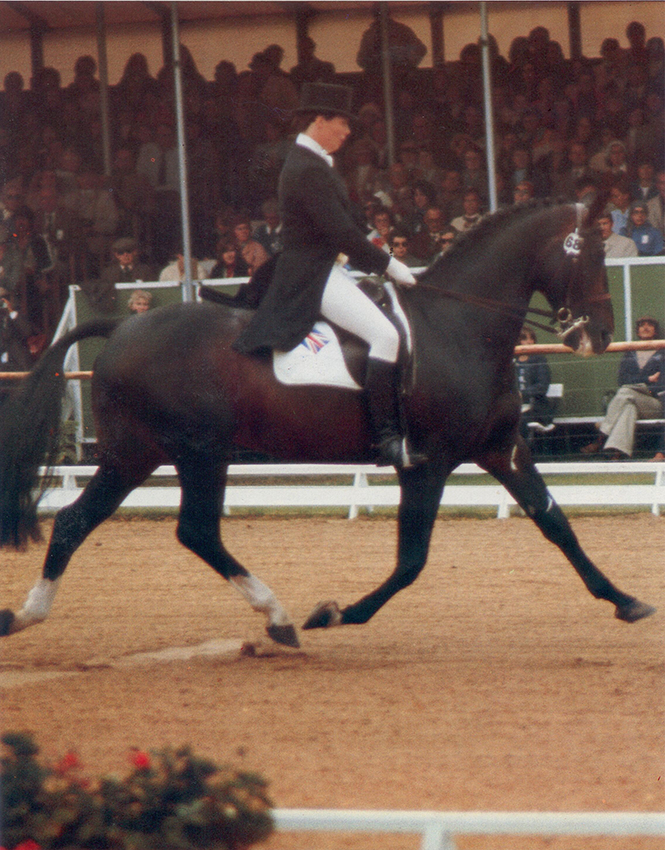 It is the sort of equestrian progression that you scarcely dare dream about. From riding the most wonderful ponies that the world has seen, then, on to your first hack to win the Hack of the Year at the age of sixteen, and, by the time you are nineteen, on the list for the British Olympic Dressage Team! Jennie Loriston-Clarke’s life has a magical ring to it. Jennie has ridden at three Olympic Games – Munich, Montreal and Los Angeles, as well as the Alternative Olympics in 1980. In 1978, she won a Bronze Medal at the World Dressage Championships, and was sixth at the 1982 Championships. At the age of forty-one, Jennie shows no signs of slowing down. She is hard at work preparing horses tor the next Olympics, as well as running her Catherston Stud in Hampshire, with her husband, Anthony, and two teenage children, Anne and Lizzie. Somewhere in the middle of an unbelievably hectic schedule, Jennie Loriston-Clark found time to visit Australia… and be our guest in The Riding Masters.
It is the sort of equestrian progression that you scarcely dare dream about. From riding the most wonderful ponies that the world has seen, then, on to your first hack to win the Hack of the Year at the age of sixteen, and, by the time you are nineteen, on the list for the British Olympic Dressage Team! Jennie Loriston-Clarke’s life has a magical ring to it. Jennie has ridden at three Olympic Games – Munich, Montreal and Los Angeles, as well as the Alternative Olympics in 1980. In 1978, she won a Bronze Medal at the World Dressage Championships, and was sixth at the 1982 Championships. At the age of forty-one, Jennie shows no signs of slowing down. She is hard at work preparing horses tor the next Olympics, as well as running her Catherston Stud in Hampshire, with her husband, Anthony, and two teenage children, Anne and Lizzie. Somewhere in the middle of an unbelievably hectic schedule, Jennie Loriston-Clark found time to visit Australia… and be our guest in The Riding Masters.
After our spate of exotic European imports, it is some sort of relief to have a of schools conducted by a member of the British Olympic Team, an instructor who is capable of unselfconsciously exclaiming: “What a Jolly Canter!”
And certainly, Jennie Loriston-Clarke has some of those traditionally gritty qualities of the British. She is certainly no wilting rose; the result jolly well will be achieved and the task is approached with an awesome professionalism. And it is no small measure of her professionalism, that Mrs Loriston-Clarke attacks the task of teaching some wayward delinquent of a horse the basic lesson of respect for the rider, with the same intensity as she does the horse that is moving onto tempe flying changes or the first steps of piaffe.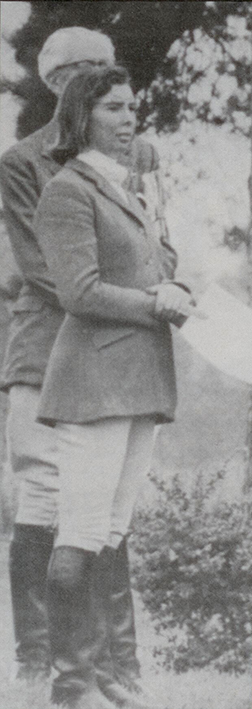
Straight-forward, precise and direct. Look again at Jennie competing at the World Championships at Lausanne – all the same qualities are there. The wonderful precision and accuracy is there, but there is an added dimension – the dimension of supreme Showmanship. Like her fellow British Olympic Team member, Tanya Larrigan (and often with her), Jennie has done much to popularise dressage in the United Kingdom – particularly with displays to music. The flair comes from a childhood of showing some of the most wonderful ponies in the world:
“I supppose Tanya grew up with her showmanship in the Circus, but I grew up showing the ponies. It was the same sort of thing – a feeling for an audience. The music is what really makes a crowd come alive. At Los Angeles, when Klimke won the medal, the Games theme music had a very distinctive beat, and within a few strides, Klimke had it and he was doing flying changes every stride in rhythm to the music. The crowd just loved it, I think they thought it was better than the Test he had ridden.”
“It’s not hard. With my horse, Bill (Dutch Courage), it needs just a few half halts until you are on the beat, and he stays there.”
It must have been a dream childhood for a youngster. Growing up, riding the famous ponies like Royal Show and stepping from the ponies to Champion Hacks and on to International Dressage Horses in charmed progression. But it was never easy, always the product of darned hard work.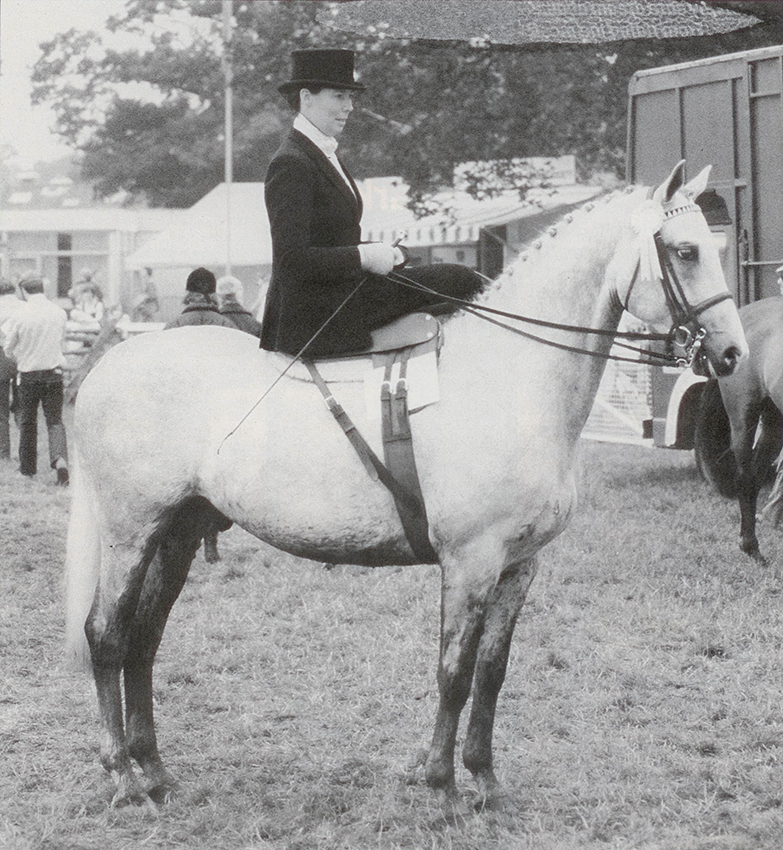
At home, Jennie starts work at six in the morning. And not surprisingly! On their 50 acre property, Jennie and her family, stand eight stallions (with something like 150 outside mares coming in during the season), and keep thirty to thirty-five horses in work – assisted by four stable staff and sixteen working students!
“We’ve got fifty-four stables, although from my husband’s last letter, there may be fifty-eight by the time I get back, he never stops building more. We have twelve horses in work for the students to learn on, a few ponies, show horses, some horses on livery – and outside horses that we produce for other people. We don’t own all the dressage horses I ride, for example Dutch Gold. It keeps one fairly busy… For young Jennie the transition from Show Rider to Dressge Rider just flowed along…
“I have been interested in dressage ever since I saw the displays given by Madam Hartel in London. She was a polio victem who could hardly walk. She had won the Silver medal at Stockholm and Helsinki. She did a fantastic display to music… again the music. Her horse was trained for her by Gunner Andersen. I eventually had lessons with him when I was about eighteen.”
“My mother was very brilliant and was way before her time as a rider and a trainer. She was interested in dressage in the ’40’s and ’50’s. She trained Royal Show for me. Royal Show did half passes and two times changes. The pony won what he won because he was so beautifully trained. And correctly trained – they were correct changes.”
“My mother used to have lessons from a German instructor, General Lindenbach. He’d been a bronze medalist back in the dark ages. He would come and stay with us for a week. He was a very old man at the time, and I suppose as children we used to poke fun at him – to our loss.”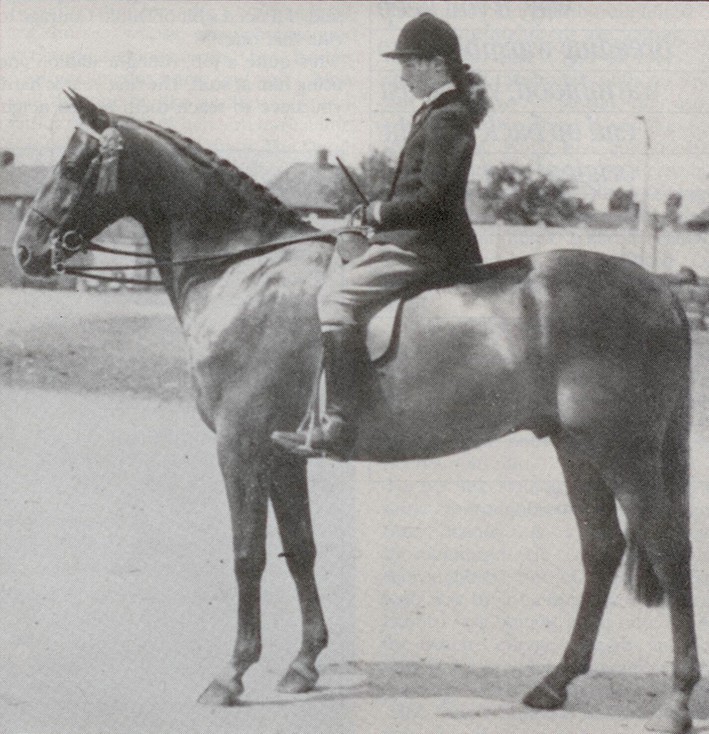
“So I was dressage brought up all my life, in a way, although perhaps I didn’t appreciate it at the time. I did Pony Club, quite a lot of eventing and showjumping.”
“When I went out of ponies I rode a hack, Desert Storm. She was a brilliant hack, but she was a difficult horse to produce – very temperamental. She was a brilliant moving horse – we won the Winston Churchill Cup for the Hack of the Year, when I was sixteen years old. She had a fabulous extended trot and a lot of crowd appeal.”
“About that time, I became involved in the Duke of Edinburgh scheme. We had to do something that we had never done before. So much to my father’s disgust, I decided to take up point to point racing. I didn’t win any races, but I was second or third each time, and eventually received my Gold Award. I was still doing dressage because Desert Storm had been retired from the Hack Ring and I was preparing her for Dressage. She was doing international level dressage within a year. When I was nineteen, we were selected to represent Britain in Europe. She was on the short list for the Mexico Olympics, but wasn’t selected in the end. She was an unreliable horse, but brilliant on her day. My sister was selected in the Event team so I went to the Olympics as groom.”
“My next horse was the stallion, Xenocles. He was a stallion and straight out of race training. He was also a grandson of Nasrullah, and everyone said ‘You are mad, they are all rogues, killers in the stable’ and he was the sweetest horse. Very sensitive, but very sweet. He went to Grand Prix, but never International, he was always a bit mouthy. Then Mrs Steel offered to buy me a dressage horse. We bought an Anglo / Trakhener in Holland, Kadett. He was trained to Intermediare. In eighteen months we went to the ’72 Olympics, and then on to Montreal. The Germans gave me a scholarship to train in Warendorf. We retired Kadett; Dutch Courage was coming on. I’d bought him in
’72. At the time he had been ridden five times – he was bred to showjump. Although I took him to Willi Schultheis, I trained him to do all the movements before we went. I wanted to train him my way. I took him there and Schultheis rode him beautifully, got off him, and suggested that he was worth a large sum of money.”
“When I first saw him, I just liked Dutch Courage’s outlook. He looked at you than through you. I’ve had three horses in my life that have given me that feeling. My first pony; Xenocles and Dutch Courage. With all three of them, I could do anything. Those horses have something extra. I have a special feeling for them. You can have all those horses in the stables, but there are only a few that you have that rapport with. While I am there they behave themselves, you go away and they say ‘Oh, the boss has gone’ and they are like mice at play. But when I am there, we have a respect for each other, and that is very important. My students still can’t saddle Dutch Courage. I’ll just walk in and say ‘Bill’ and he stands like a lamb. ‘Oh’, he says, ‘Master is here’. The horses with the character and the personality are the better horses in the end.”
“When I first saw Bill he was a right raver. He was very wild. Not wild, rampant. He came into the yard like a lion. That’s where he got his name, I said, ‘I’ll need a bit of Dutch Courage to ride that one’.”
“It’s quite a job, riding a stallion and using him at stud. The first year is hard, you have to teach them not to neigh, you can’t have stallions screaming their heads off all the time. They are all well behaved now. We never take the stallions away from home to cover mares. They learn that when they go out, they go out to work. But you do have to be careful with competition horses.”
“Bill’s son, Dutch Gold, he is like that. He is a wild creature with his eye on the birds. That’s why I took him eventing; I thought it would be good for him to come home tired a few nights. He won the Novice National Event Championships (as well as three other ODEs ) and two days later, he was tenth in the Prix St Georges at Rotterdam. This year at Aachen, he was second, third and fourth. In the Intermediare 1, the highest level he contested, he was second.”
“I think the showjumping and eventing did him good. He whips in to the hounds. He’s a horse that wants plenty to do. We’ll hunt quietly all day and he gets a bit tired and I say ‘Come on dear, just a bit more’, and the next day, he is delightful in the dressage arena.”
“Eventing and hunting shouldn’t get the horse excited. They only get excited if the rider gets excited. They only get anxious if they are pushed. We don’t do a lot of galloping around on the hunting field. I can’t stand going with the crowd, and I’m not a great one for following any Master. We just stay with the whipper-in.”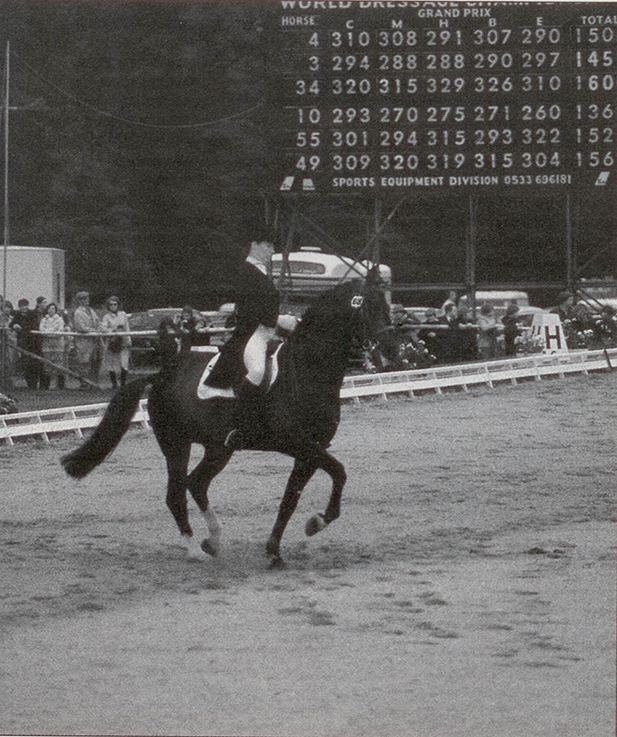
“It’s not a training program that you would use with every horse. But it is a great help with a horse that gets annoyed with the discipline of dressage. If you put a harsh rider on him, the rider would drive him loopy before he submitted. One would kill the other! I don’t like to break their spirit. They are very much personalities. These things with a lot of thoroughbred in them, you have to be careful with. They are brilliant if you can keep them right, but you have got to be a diplomatic rider.”
“It is so interesting now that we have been breeding for quite a time. I am riding horses whose grandparents and even great-grandparents, I’ve ridden. You get on the horse and say : ‘Now will this one be like mother, or grandfather or uncle?’. When you have a line, it is fascinating to ride them. The Dutch Courages are a delight. They are so easy, so balanced. I am riding one five year old now. He’s doing lateral work, flying changes, and his extension is just breath taking. He is 1 7 hands 1 inch. Massive – that is a lot of horse. What we would call a middle weight hunter – and yet he floats! He is the best young horse we’ve ever had … but I never wanted him so big. His mother is 16. 1, his father, 16. 1… but Dutch Bid just kept growing. His full-brother, Dutch Auction is Eventing in Germany now. He won three events as soon as he arrived in Germany.”
Jennie’s breeding program seeks to combine the best of both worlds. The strength and bone of the Warmbloods; the brilliance of the thoroughbred.
“Our thoroughbreds are getting very much like what I see of yours, too small, little racehorses with no bone. But you can go too far the other way, if you keep breeding warmblood to warmblood, you’ll just end up back with the original cart horse. I can show you a photo of one of Dutch Courage’s grand-mothers, and she would happily plough your fields. I like a relatively high mixture of thoroughbred. One half to three quarters thoroughbred is ideal.”
“When I first saw Dutch Courage he was only 15.3 hh, but he had good bone. I thought he would be a good stallion for our thoroughbred mares even if he wasn’t a dressage horse. But he has done both brilliantly – he has been a gold mine.”
For her next stallion, Jennie went to another thoroughbred / warmblood mixture. Ramiro is a three quarter thoroughbred. He is by an English thoroughbred out of a Dutch mare, who was by a German thoroughbred. Ramiro was bought as an outcross for the Dutch Courage progeny, and only now is the breeding program reaching the stage where the lines are crossing. Like Dutch Courage, Ramiro has proven himself an exceptional performer as well as a sire. Ramiro is now doing Grand Prix work, although he hasn’t yet competed at that level. Jennie looks forward to competing at the next Olympics on either Ramiro, or Dutch Gold… ” although I also have a very good English thoroughbred, White Christmas, but he might be a bit small.”
Like all real riders, Jennie Loriston-Clarke acquires her horse knowledge from a variety of sources · drawing heavily on the teaching of the Germans.
“We perhaps have a more light hearted approach, which sometimes doesn’t do us any good, but sometimes it does.”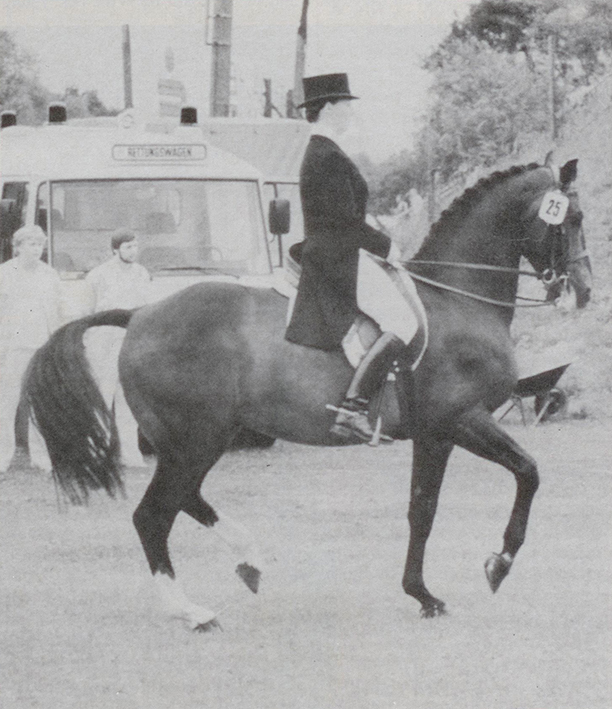
“Before I went to Germany I lacked all knowledge of the thoroughness and dedication that was needed to be a dressage competitor. I learnt a lot about attention to detail, to thoroughness, and about continuing until you had met with a modicum of success.”
“That last lesson is one you must be careful with. You can keep going until you go backwards. You must stop before you go over the hill, even if you haven’t achieved the goal. Knowing when to go on and knowing when to stop is perhaps the crunch of what makes a good trainer.”
“Before I went to Germany, I lacked discipline in my own training, and therefore in my horses. It was an opportunity to see the overall approach to training, rather than just going to an instructor for a week. You learn a lot from watching, taking out the best bits. No trainer or rider is perfect, you must select. I’ve seen a lot of things that I would rather forget, and a lot of things that I admire.”
This article first appeared in the February 1985 issue of THM.


